University Case Study: Analyzing Pret A Manger's Business Operations
VerifiedAdded on 2020/04/15
|32
|7697
|3050
Case Study
AI Summary
This case study analyzes Pret A Manger, a fast-food chain, examining its business operations, challenges, and strategic approaches. It delves into the company's background, including its establishment and expansion, and identifies key problems such as high costs and location challenges. The report explores research questions regarding improvements, problem-solving, and strategic models. It presents a SWOT analysis, highlighting strengths like brand reputation and weaknesses like high prices. The analysis covers marketing strategies, international business strategies using tools like Porter's Competitive Advantage, and strategic management. The study provides proposed solutions for local market development and global expansion, concluding with recommendations for Pret A Manger's future growth and addressing limitations and scope for further research. The report also examines Pret A Manger's financial performance and market entry strategies.
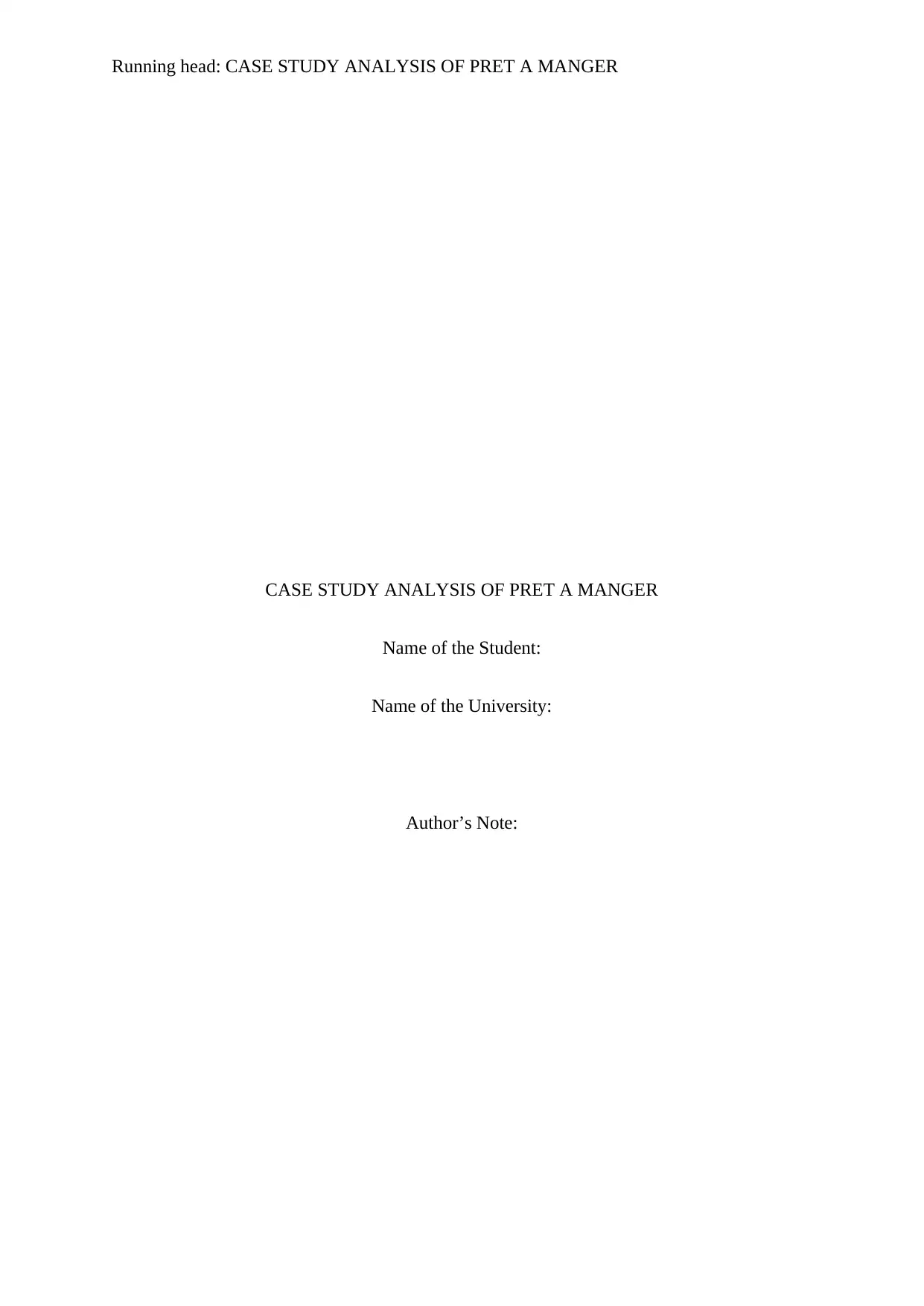
Running head: CASE STUDY ANALYSIS OF PRET A MANGER
CASE STUDY ANALYSIS OF PRET A MANGER
Name of the Student:
Name of the University:
Author’s Note:
CASE STUDY ANALYSIS OF PRET A MANGER
Name of the Student:
Name of the University:
Author’s Note:
Paraphrase This Document
Need a fresh take? Get an instant paraphrase of this document with our AI Paraphraser
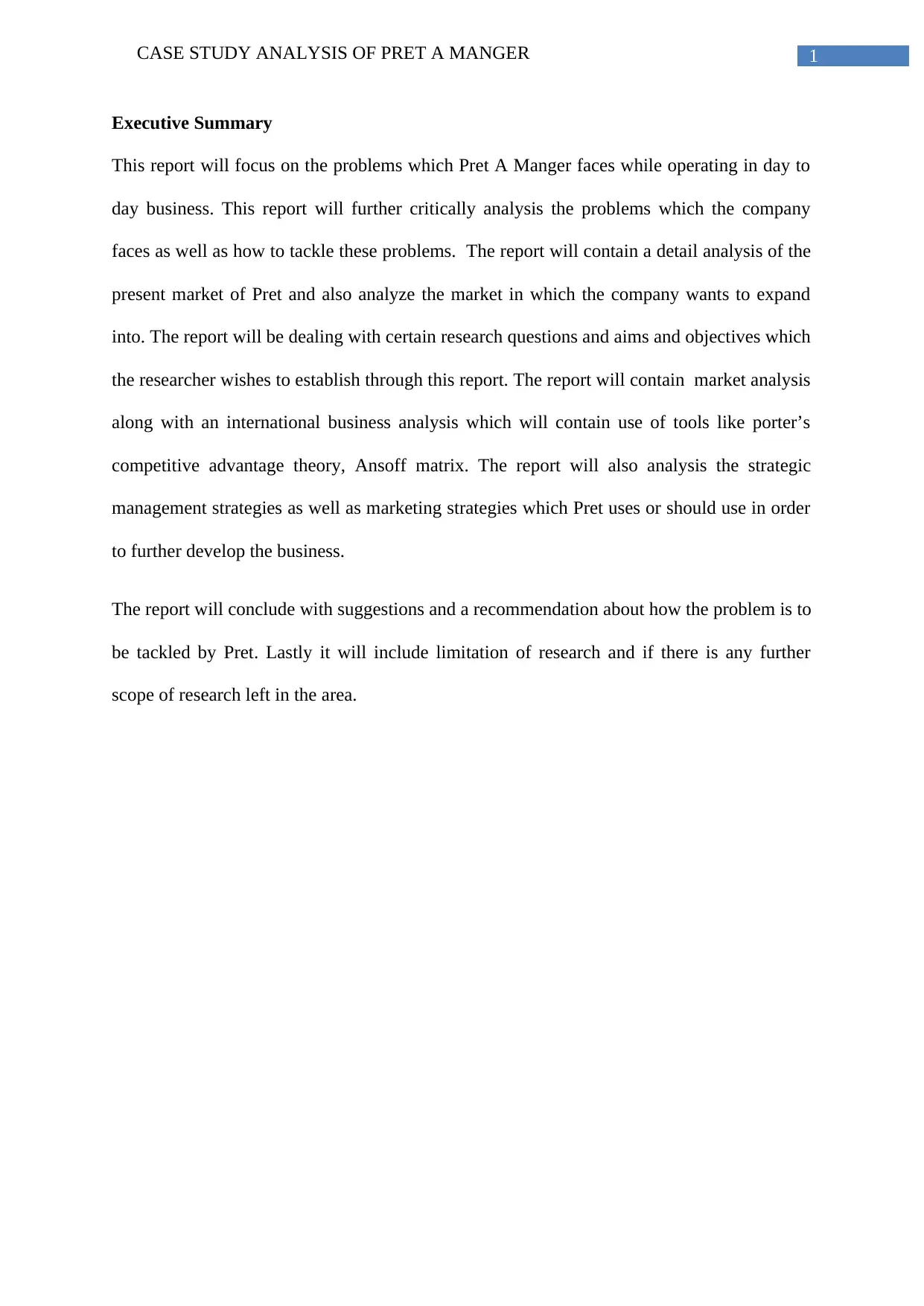
1CASE STUDY ANALYSIS OF PRET A MANGER
Executive Summary
This report will focus on the problems which Pret A Manger faces while operating in day to
day business. This report will further critically analysis the problems which the company
faces as well as how to tackle these problems. The report will contain a detail analysis of the
present market of Pret and also analyze the market in which the company wants to expand
into. The report will be dealing with certain research questions and aims and objectives which
the researcher wishes to establish through this report. The report will contain market analysis
along with an international business analysis which will contain use of tools like porter’s
competitive advantage theory, Ansoff matrix. The report will also analysis the strategic
management strategies as well as marketing strategies which Pret uses or should use in order
to further develop the business.
The report will conclude with suggestions and a recommendation about how the problem is to
be tackled by Pret. Lastly it will include limitation of research and if there is any further
scope of research left in the area.
Executive Summary
This report will focus on the problems which Pret A Manger faces while operating in day to
day business. This report will further critically analysis the problems which the company
faces as well as how to tackle these problems. The report will contain a detail analysis of the
present market of Pret and also analyze the market in which the company wants to expand
into. The report will be dealing with certain research questions and aims and objectives which
the researcher wishes to establish through this report. The report will contain market analysis
along with an international business analysis which will contain use of tools like porter’s
competitive advantage theory, Ansoff matrix. The report will also analysis the strategic
management strategies as well as marketing strategies which Pret uses or should use in order
to further develop the business.
The report will conclude with suggestions and a recommendation about how the problem is to
be tackled by Pret. Lastly it will include limitation of research and if there is any further
scope of research left in the area.
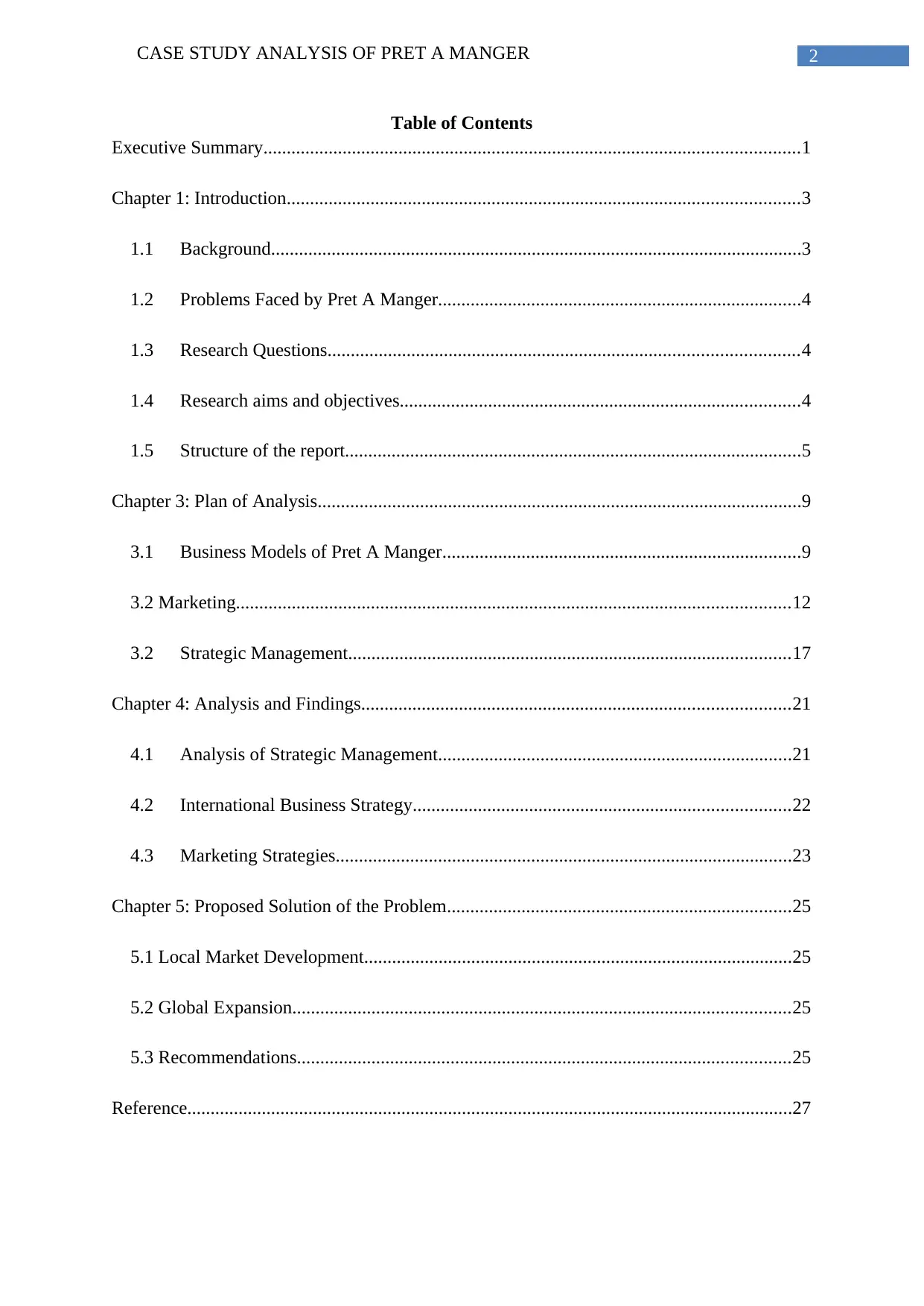
2CASE STUDY ANALYSIS OF PRET A MANGER
Table of Contents
Executive Summary...................................................................................................................1
Chapter 1: Introduction..............................................................................................................3
1.1 Background..................................................................................................................3
1.2 Problems Faced by Pret A Manger..............................................................................4
1.3 Research Questions.....................................................................................................4
1.4 Research aims and objectives......................................................................................4
1.5 Structure of the report..................................................................................................5
Chapter 3: Plan of Analysis........................................................................................................9
3.1 Business Models of Pret A Manger.............................................................................9
3.2 Marketing.......................................................................................................................12
3.2 Strategic Management...............................................................................................17
Chapter 4: Analysis and Findings............................................................................................21
4.1 Analysis of Strategic Management............................................................................21
4.2 International Business Strategy.................................................................................22
4.3 Marketing Strategies..................................................................................................23
Chapter 5: Proposed Solution of the Problem..........................................................................25
5.1 Local Market Development............................................................................................25
5.2 Global Expansion...........................................................................................................25
5.3 Recommendations..........................................................................................................25
Reference..................................................................................................................................27
Table of Contents
Executive Summary...................................................................................................................1
Chapter 1: Introduction..............................................................................................................3
1.1 Background..................................................................................................................3
1.2 Problems Faced by Pret A Manger..............................................................................4
1.3 Research Questions.....................................................................................................4
1.4 Research aims and objectives......................................................................................4
1.5 Structure of the report..................................................................................................5
Chapter 3: Plan of Analysis........................................................................................................9
3.1 Business Models of Pret A Manger.............................................................................9
3.2 Marketing.......................................................................................................................12
3.2 Strategic Management...............................................................................................17
Chapter 4: Analysis and Findings............................................................................................21
4.1 Analysis of Strategic Management............................................................................21
4.2 International Business Strategy.................................................................................22
4.3 Marketing Strategies..................................................................................................23
Chapter 5: Proposed Solution of the Problem..........................................................................25
5.1 Local Market Development............................................................................................25
5.2 Global Expansion...........................................................................................................25
5.3 Recommendations..........................................................................................................25
Reference..................................................................................................................................27
⊘ This is a preview!⊘
Do you want full access?
Subscribe today to unlock all pages.

Trusted by 1+ million students worldwide
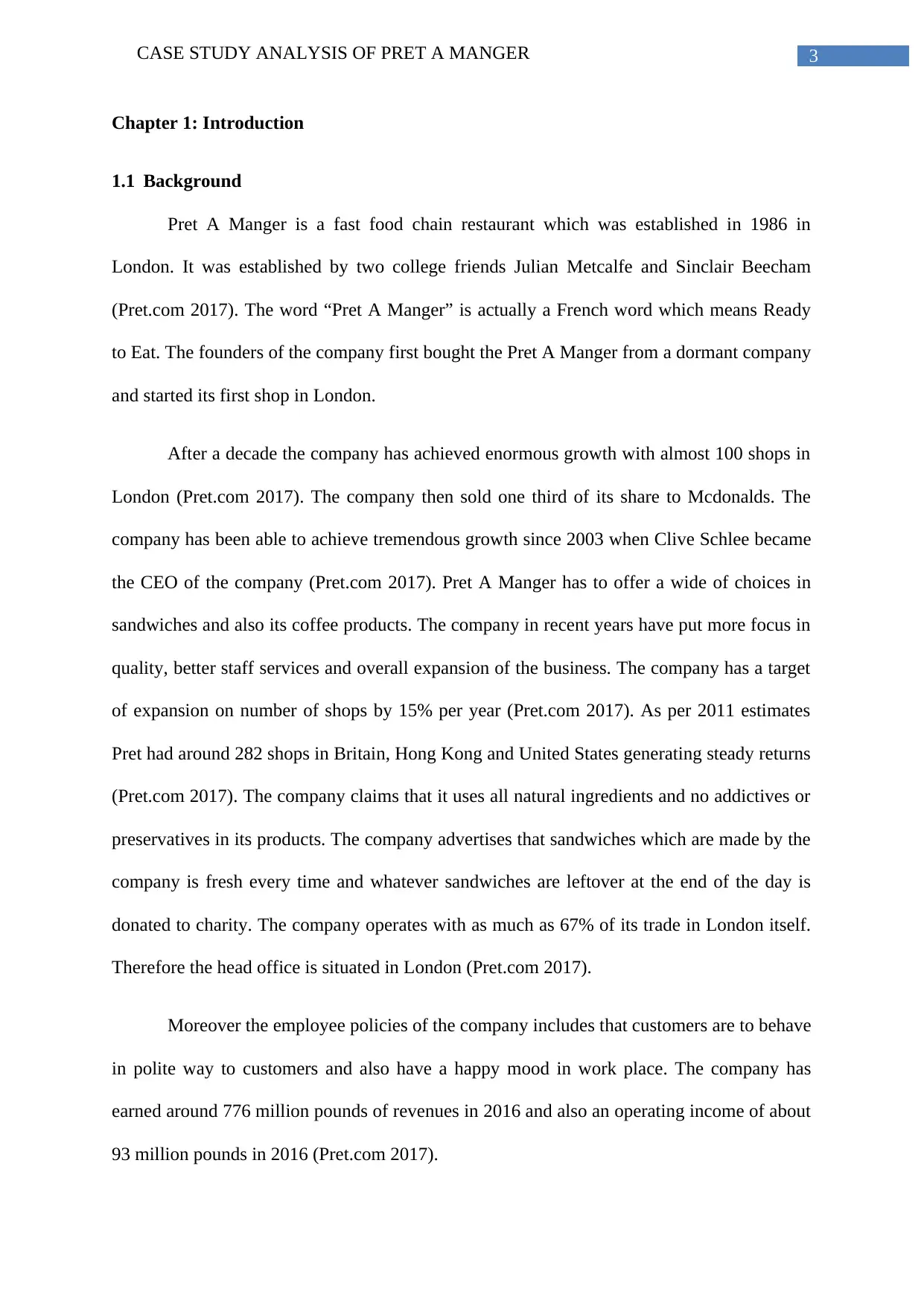
3CASE STUDY ANALYSIS OF PRET A MANGER
Chapter 1: Introduction
1.1 Background
Pret A Manger is a fast food chain restaurant which was established in 1986 in
London. It was established by two college friends Julian Metcalfe and Sinclair Beecham
(Pret.com 2017). The word “Pret A Manger” is actually a French word which means Ready
to Eat. The founders of the company first bought the Pret A Manger from a dormant company
and started its first shop in London.
After a decade the company has achieved enormous growth with almost 100 shops in
London (Pret.com 2017). The company then sold one third of its share to Mcdonalds. The
company has been able to achieve tremendous growth since 2003 when Clive Schlee became
the CEO of the company (Pret.com 2017). Pret A Manger has to offer a wide of choices in
sandwiches and also its coffee products. The company in recent years have put more focus in
quality, better staff services and overall expansion of the business. The company has a target
of expansion on number of shops by 15% per year (Pret.com 2017). As per 2011 estimates
Pret had around 282 shops in Britain, Hong Kong and United States generating steady returns
(Pret.com 2017). The company claims that it uses all natural ingredients and no addictives or
preservatives in its products. The company advertises that sandwiches which are made by the
company is fresh every time and whatever sandwiches are leftover at the end of the day is
donated to charity. The company operates with as much as 67% of its trade in London itself.
Therefore the head office is situated in London (Pret.com 2017).
Moreover the employee policies of the company includes that customers are to behave
in polite way to customers and also have a happy mood in work place. The company has
earned around 776 million pounds of revenues in 2016 and also an operating income of about
93 million pounds in 2016 (Pret.com 2017).
Chapter 1: Introduction
1.1 Background
Pret A Manger is a fast food chain restaurant which was established in 1986 in
London. It was established by two college friends Julian Metcalfe and Sinclair Beecham
(Pret.com 2017). The word “Pret A Manger” is actually a French word which means Ready
to Eat. The founders of the company first bought the Pret A Manger from a dormant company
and started its first shop in London.
After a decade the company has achieved enormous growth with almost 100 shops in
London (Pret.com 2017). The company then sold one third of its share to Mcdonalds. The
company has been able to achieve tremendous growth since 2003 when Clive Schlee became
the CEO of the company (Pret.com 2017). Pret A Manger has to offer a wide of choices in
sandwiches and also its coffee products. The company in recent years have put more focus in
quality, better staff services and overall expansion of the business. The company has a target
of expansion on number of shops by 15% per year (Pret.com 2017). As per 2011 estimates
Pret had around 282 shops in Britain, Hong Kong and United States generating steady returns
(Pret.com 2017). The company claims that it uses all natural ingredients and no addictives or
preservatives in its products. The company advertises that sandwiches which are made by the
company is fresh every time and whatever sandwiches are leftover at the end of the day is
donated to charity. The company operates with as much as 67% of its trade in London itself.
Therefore the head office is situated in London (Pret.com 2017).
Moreover the employee policies of the company includes that customers are to behave
in polite way to customers and also have a happy mood in work place. The company has
earned around 776 million pounds of revenues in 2016 and also an operating income of about
93 million pounds in 2016 (Pret.com 2017).
Paraphrase This Document
Need a fresh take? Get an instant paraphrase of this document with our AI Paraphraser
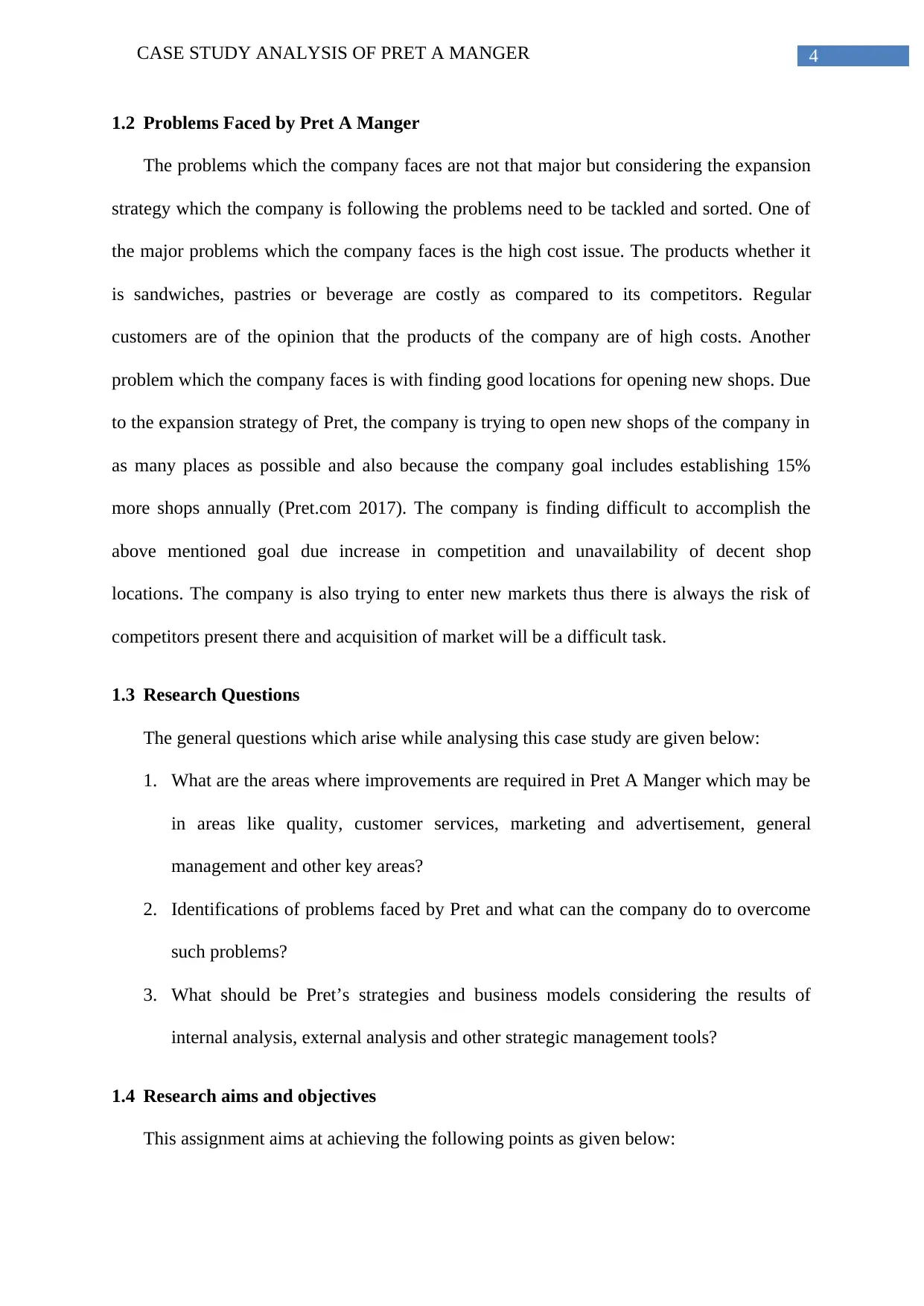
4CASE STUDY ANALYSIS OF PRET A MANGER
1.2 Problems Faced by Pret A Manger
The problems which the company faces are not that major but considering the expansion
strategy which the company is following the problems need to be tackled and sorted. One of
the major problems which the company faces is the high cost issue. The products whether it
is sandwiches, pastries or beverage are costly as compared to its competitors. Regular
customers are of the opinion that the products of the company are of high costs. Another
problem which the company faces is with finding good locations for opening new shops. Due
to the expansion strategy of Pret, the company is trying to open new shops of the company in
as many places as possible and also because the company goal includes establishing 15%
more shops annually (Pret.com 2017). The company is finding difficult to accomplish the
above mentioned goal due increase in competition and unavailability of decent shop
locations. The company is also trying to enter new markets thus there is always the risk of
competitors present there and acquisition of market will be a difficult task.
1.3 Research Questions
The general questions which arise while analysing this case study are given below:
1. What are the areas where improvements are required in Pret A Manger which may be
in areas like quality, customer services, marketing and advertisement, general
management and other key areas?
2. Identifications of problems faced by Pret and what can the company do to overcome
such problems?
3. What should be Pret’s strategies and business models considering the results of
internal analysis, external analysis and other strategic management tools?
1.4 Research aims and objectives
This assignment aims at achieving the following points as given below:
1.2 Problems Faced by Pret A Manger
The problems which the company faces are not that major but considering the expansion
strategy which the company is following the problems need to be tackled and sorted. One of
the major problems which the company faces is the high cost issue. The products whether it
is sandwiches, pastries or beverage are costly as compared to its competitors. Regular
customers are of the opinion that the products of the company are of high costs. Another
problem which the company faces is with finding good locations for opening new shops. Due
to the expansion strategy of Pret, the company is trying to open new shops of the company in
as many places as possible and also because the company goal includes establishing 15%
more shops annually (Pret.com 2017). The company is finding difficult to accomplish the
above mentioned goal due increase in competition and unavailability of decent shop
locations. The company is also trying to enter new markets thus there is always the risk of
competitors present there and acquisition of market will be a difficult task.
1.3 Research Questions
The general questions which arise while analysing this case study are given below:
1. What are the areas where improvements are required in Pret A Manger which may be
in areas like quality, customer services, marketing and advertisement, general
management and other key areas?
2. Identifications of problems faced by Pret and what can the company do to overcome
such problems?
3. What should be Pret’s strategies and business models considering the results of
internal analysis, external analysis and other strategic management tools?
1.4 Research aims and objectives
This assignment aims at achieving the following points as given below:
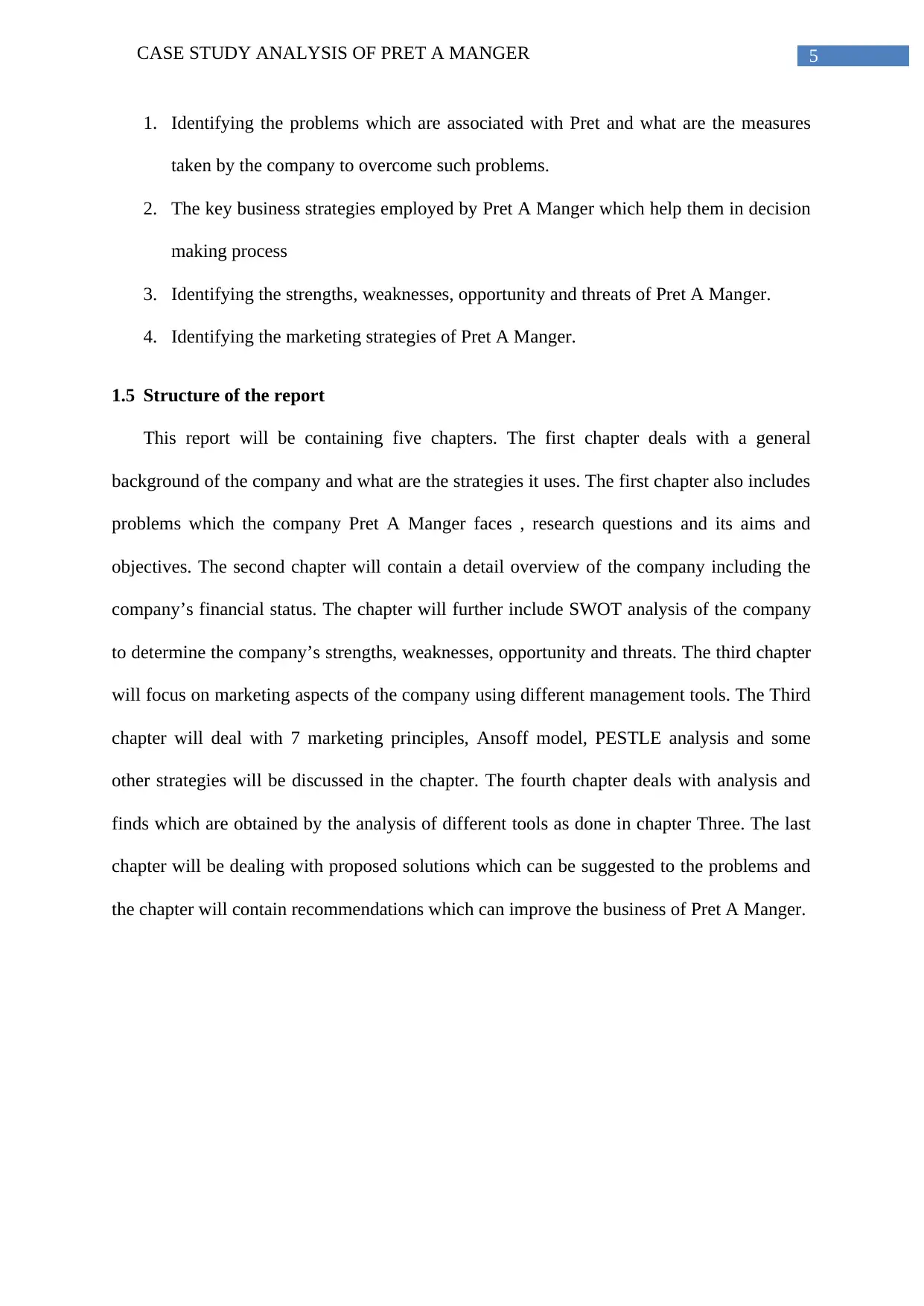
5CASE STUDY ANALYSIS OF PRET A MANGER
1. Identifying the problems which are associated with Pret and what are the measures
taken by the company to overcome such problems.
2. The key business strategies employed by Pret A Manger which help them in decision
making process
3. Identifying the strengths, weaknesses, opportunity and threats of Pret A Manger.
4. Identifying the marketing strategies of Pret A Manger.
1.5 Structure of the report
This report will be containing five chapters. The first chapter deals with a general
background of the company and what are the strategies it uses. The first chapter also includes
problems which the company Pret A Manger faces , research questions and its aims and
objectives. The second chapter will contain a detail overview of the company including the
company’s financial status. The chapter will further include SWOT analysis of the company
to determine the company’s strengths, weaknesses, opportunity and threats. The third chapter
will focus on marketing aspects of the company using different management tools. The Third
chapter will deal with 7 marketing principles, Ansoff model, PESTLE analysis and some
other strategies will be discussed in the chapter. The fourth chapter deals with analysis and
finds which are obtained by the analysis of different tools as done in chapter Three. The last
chapter will be dealing with proposed solutions which can be suggested to the problems and
the chapter will contain recommendations which can improve the business of Pret A Manger.
1. Identifying the problems which are associated with Pret and what are the measures
taken by the company to overcome such problems.
2. The key business strategies employed by Pret A Manger which help them in decision
making process
3. Identifying the strengths, weaknesses, opportunity and threats of Pret A Manger.
4. Identifying the marketing strategies of Pret A Manger.
1.5 Structure of the report
This report will be containing five chapters. The first chapter deals with a general
background of the company and what are the strategies it uses. The first chapter also includes
problems which the company Pret A Manger faces , research questions and its aims and
objectives. The second chapter will contain a detail overview of the company including the
company’s financial status. The chapter will further include SWOT analysis of the company
to determine the company’s strengths, weaknesses, opportunity and threats. The third chapter
will focus on marketing aspects of the company using different management tools. The Third
chapter will deal with 7 marketing principles, Ansoff model, PESTLE analysis and some
other strategies will be discussed in the chapter. The fourth chapter deals with analysis and
finds which are obtained by the analysis of different tools as done in chapter Three. The last
chapter will be dealing with proposed solutions which can be suggested to the problems and
the chapter will contain recommendations which can improve the business of Pret A Manger.
⊘ This is a preview!⊘
Do you want full access?
Subscribe today to unlock all pages.

Trusted by 1+ million students worldwide
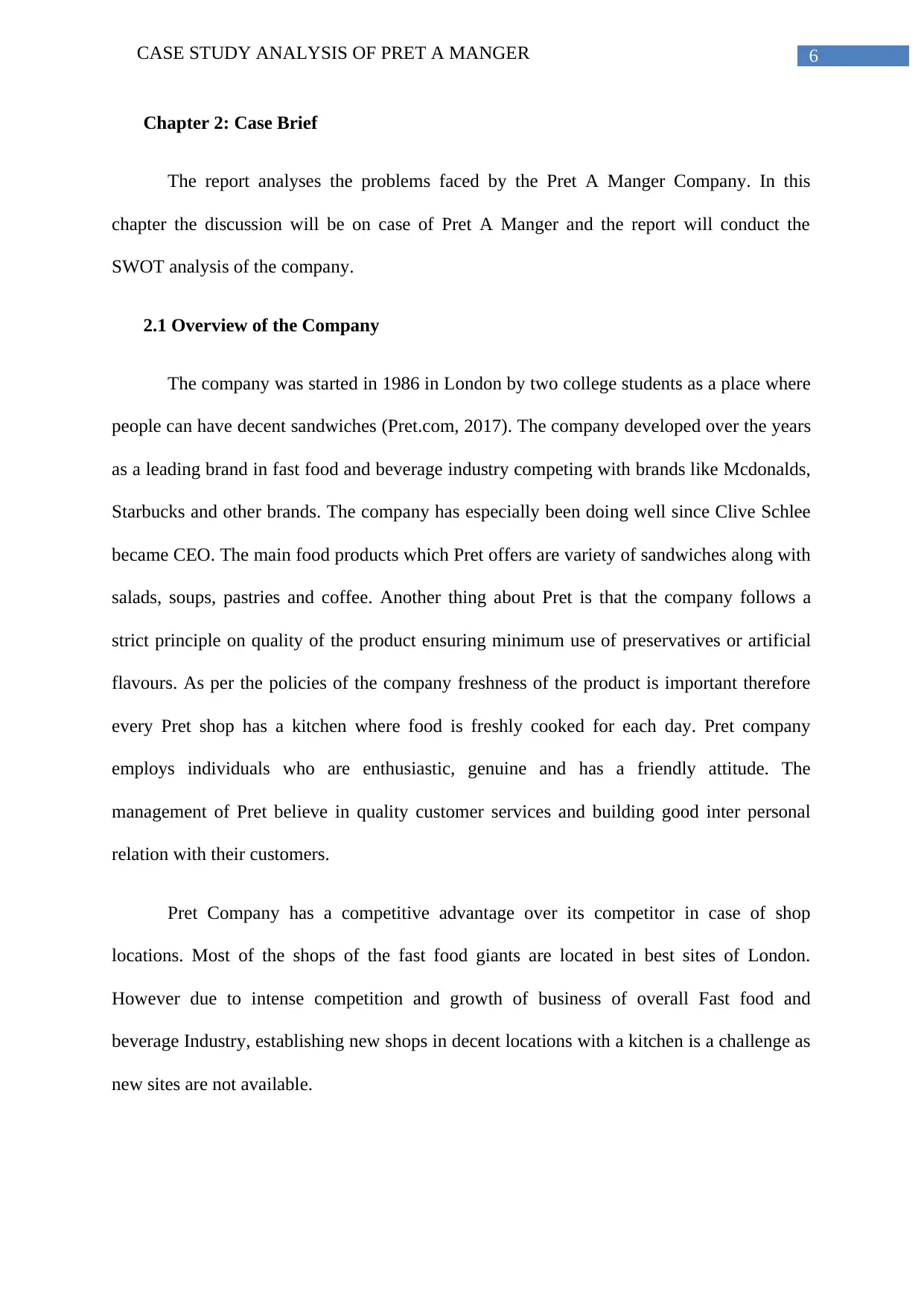
6CASE STUDY ANALYSIS OF PRET A MANGER
Chapter 2: Case Brief
The report analyses the problems faced by the Pret A Manger Company. In this
chapter the discussion will be on case of Pret A Manger and the report will conduct the
SWOT analysis of the company.
2.1 Overview of the Company
The company was started in 1986 in London by two college students as a place where
people can have decent sandwiches (Pret.com, 2017). The company developed over the years
as a leading brand in fast food and beverage industry competing with brands like Mcdonalds,
Starbucks and other brands. The company has especially been doing well since Clive Schlee
became CEO. The main food products which Pret offers are variety of sandwiches along with
salads, soups, pastries and coffee. Another thing about Pret is that the company follows a
strict principle on quality of the product ensuring minimum use of preservatives or artificial
flavours. As per the policies of the company freshness of the product is important therefore
every Pret shop has a kitchen where food is freshly cooked for each day. Pret company
employs individuals who are enthusiastic, genuine and has a friendly attitude. The
management of Pret believe in quality customer services and building good inter personal
relation with their customers.
Pret Company has a competitive advantage over its competitor in case of shop
locations. Most of the shops of the fast food giants are located in best sites of London.
However due to intense competition and growth of business of overall Fast food and
beverage Industry, establishing new shops in decent locations with a kitchen is a challenge as
new sites are not available.
Chapter 2: Case Brief
The report analyses the problems faced by the Pret A Manger Company. In this
chapter the discussion will be on case of Pret A Manger and the report will conduct the
SWOT analysis of the company.
2.1 Overview of the Company
The company was started in 1986 in London by two college students as a place where
people can have decent sandwiches (Pret.com, 2017). The company developed over the years
as a leading brand in fast food and beverage industry competing with brands like Mcdonalds,
Starbucks and other brands. The company has especially been doing well since Clive Schlee
became CEO. The main food products which Pret offers are variety of sandwiches along with
salads, soups, pastries and coffee. Another thing about Pret is that the company follows a
strict principle on quality of the product ensuring minimum use of preservatives or artificial
flavours. As per the policies of the company freshness of the product is important therefore
every Pret shop has a kitchen where food is freshly cooked for each day. Pret company
employs individuals who are enthusiastic, genuine and has a friendly attitude. The
management of Pret believe in quality customer services and building good inter personal
relation with their customers.
Pret Company has a competitive advantage over its competitor in case of shop
locations. Most of the shops of the fast food giants are located in best sites of London.
However due to intense competition and growth of business of overall Fast food and
beverage Industry, establishing new shops in decent locations with a kitchen is a challenge as
new sites are not available.
Paraphrase This Document
Need a fresh take? Get an instant paraphrase of this document with our AI Paraphraser
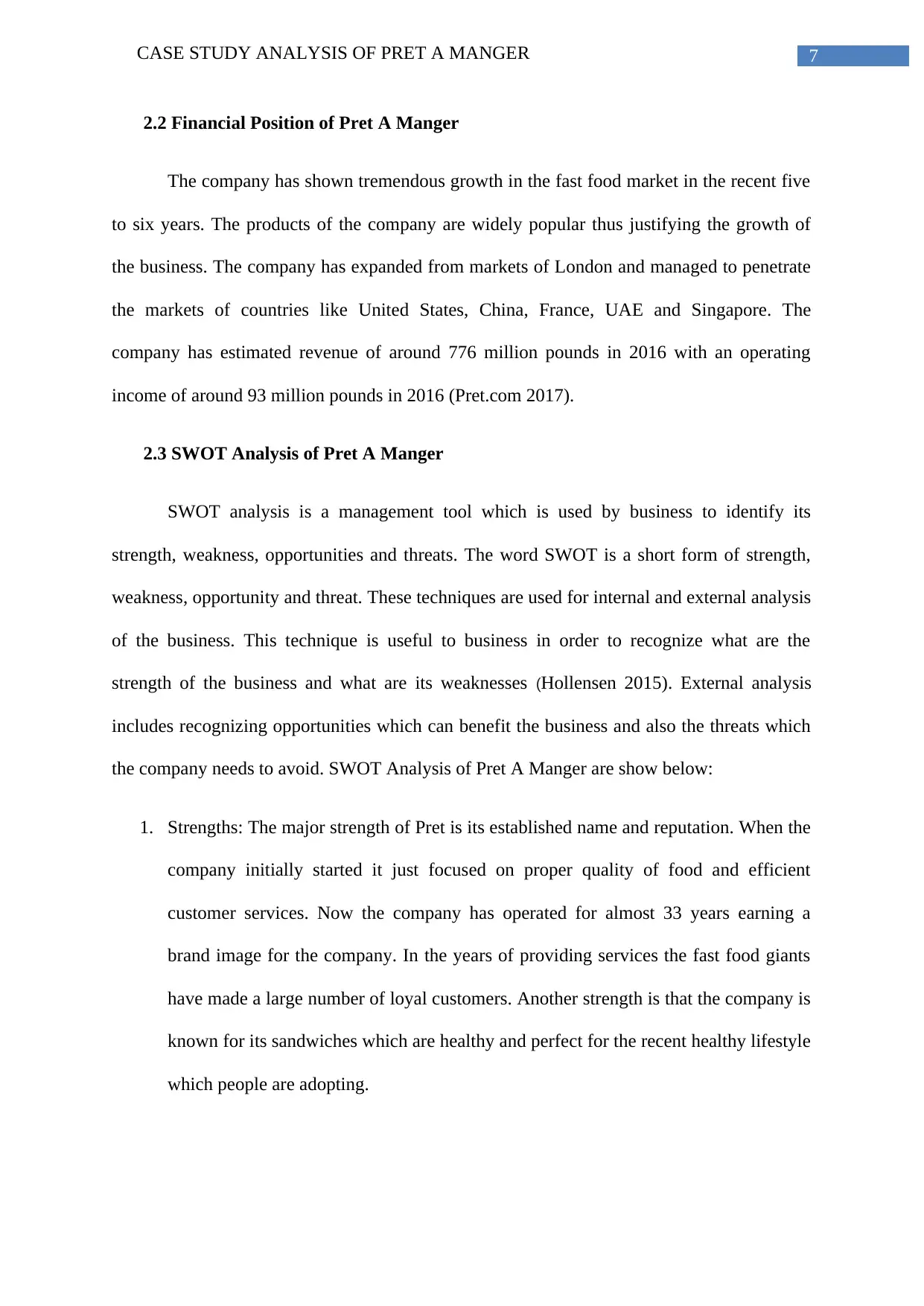
7CASE STUDY ANALYSIS OF PRET A MANGER
2.2 Financial Position of Pret A Manger
The company has shown tremendous growth in the fast food market in the recent five
to six years. The products of the company are widely popular thus justifying the growth of
the business. The company has expanded from markets of London and managed to penetrate
the markets of countries like United States, China, France, UAE and Singapore. The
company has estimated revenue of around 776 million pounds in 2016 with an operating
income of around 93 million pounds in 2016 (Pret.com 2017).
2.3 SWOT Analysis of Pret A Manger
SWOT analysis is a management tool which is used by business to identify its
strength, weakness, opportunities and threats. The word SWOT is a short form of strength,
weakness, opportunity and threat. These techniques are used for internal and external analysis
of the business. This technique is useful to business in order to recognize what are the
strength of the business and what are its weaknesses (Hollensen 2015). External analysis
includes recognizing opportunities which can benefit the business and also the threats which
the company needs to avoid. SWOT Analysis of Pret A Manger are show below:
1. Strengths: The major strength of Pret is its established name and reputation. When the
company initially started it just focused on proper quality of food and efficient
customer services. Now the company has operated for almost 33 years earning a
brand image for the company. In the years of providing services the fast food giants
have made a large number of loyal customers. Another strength is that the company is
known for its sandwiches which are healthy and perfect for the recent healthy lifestyle
which people are adopting.
2.2 Financial Position of Pret A Manger
The company has shown tremendous growth in the fast food market in the recent five
to six years. The products of the company are widely popular thus justifying the growth of
the business. The company has expanded from markets of London and managed to penetrate
the markets of countries like United States, China, France, UAE and Singapore. The
company has estimated revenue of around 776 million pounds in 2016 with an operating
income of around 93 million pounds in 2016 (Pret.com 2017).
2.3 SWOT Analysis of Pret A Manger
SWOT analysis is a management tool which is used by business to identify its
strength, weakness, opportunities and threats. The word SWOT is a short form of strength,
weakness, opportunity and threat. These techniques are used for internal and external analysis
of the business. This technique is useful to business in order to recognize what are the
strength of the business and what are its weaknesses (Hollensen 2015). External analysis
includes recognizing opportunities which can benefit the business and also the threats which
the company needs to avoid. SWOT Analysis of Pret A Manger are show below:
1. Strengths: The major strength of Pret is its established name and reputation. When the
company initially started it just focused on proper quality of food and efficient
customer services. Now the company has operated for almost 33 years earning a
brand image for the company. In the years of providing services the fast food giants
have made a large number of loyal customers. Another strength is that the company is
known for its sandwiches which are healthy and perfect for the recent healthy lifestyle
which people are adopting.
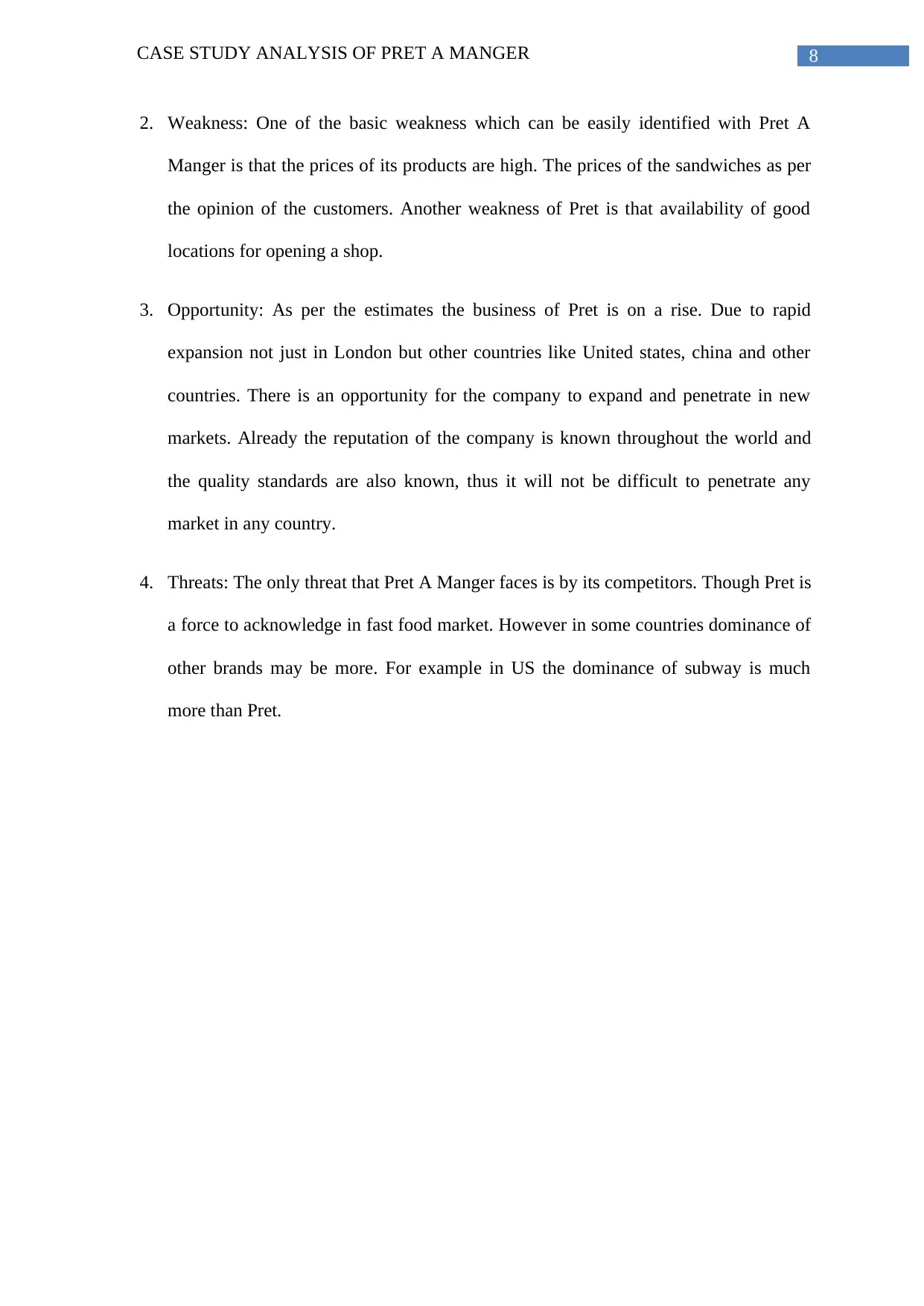
8CASE STUDY ANALYSIS OF PRET A MANGER
2. Weakness: One of the basic weakness which can be easily identified with Pret A
Manger is that the prices of its products are high. The prices of the sandwiches as per
the opinion of the customers. Another weakness of Pret is that availability of good
locations for opening a shop.
3. Opportunity: As per the estimates the business of Pret is on a rise. Due to rapid
expansion not just in London but other countries like United states, china and other
countries. There is an opportunity for the company to expand and penetrate in new
markets. Already the reputation of the company is known throughout the world and
the quality standards are also known, thus it will not be difficult to penetrate any
market in any country.
4. Threats: The only threat that Pret A Manger faces is by its competitors. Though Pret is
a force to acknowledge in fast food market. However in some countries dominance of
other brands may be more. For example in US the dominance of subway is much
more than Pret.
2. Weakness: One of the basic weakness which can be easily identified with Pret A
Manger is that the prices of its products are high. The prices of the sandwiches as per
the opinion of the customers. Another weakness of Pret is that availability of good
locations for opening a shop.
3. Opportunity: As per the estimates the business of Pret is on a rise. Due to rapid
expansion not just in London but other countries like United states, china and other
countries. There is an opportunity for the company to expand and penetrate in new
markets. Already the reputation of the company is known throughout the world and
the quality standards are also known, thus it will not be difficult to penetrate any
market in any country.
4. Threats: The only threat that Pret A Manger faces is by its competitors. Though Pret is
a force to acknowledge in fast food market. However in some countries dominance of
other brands may be more. For example in US the dominance of subway is much
more than Pret.
⊘ This is a preview!⊘
Do you want full access?
Subscribe today to unlock all pages.

Trusted by 1+ million students worldwide
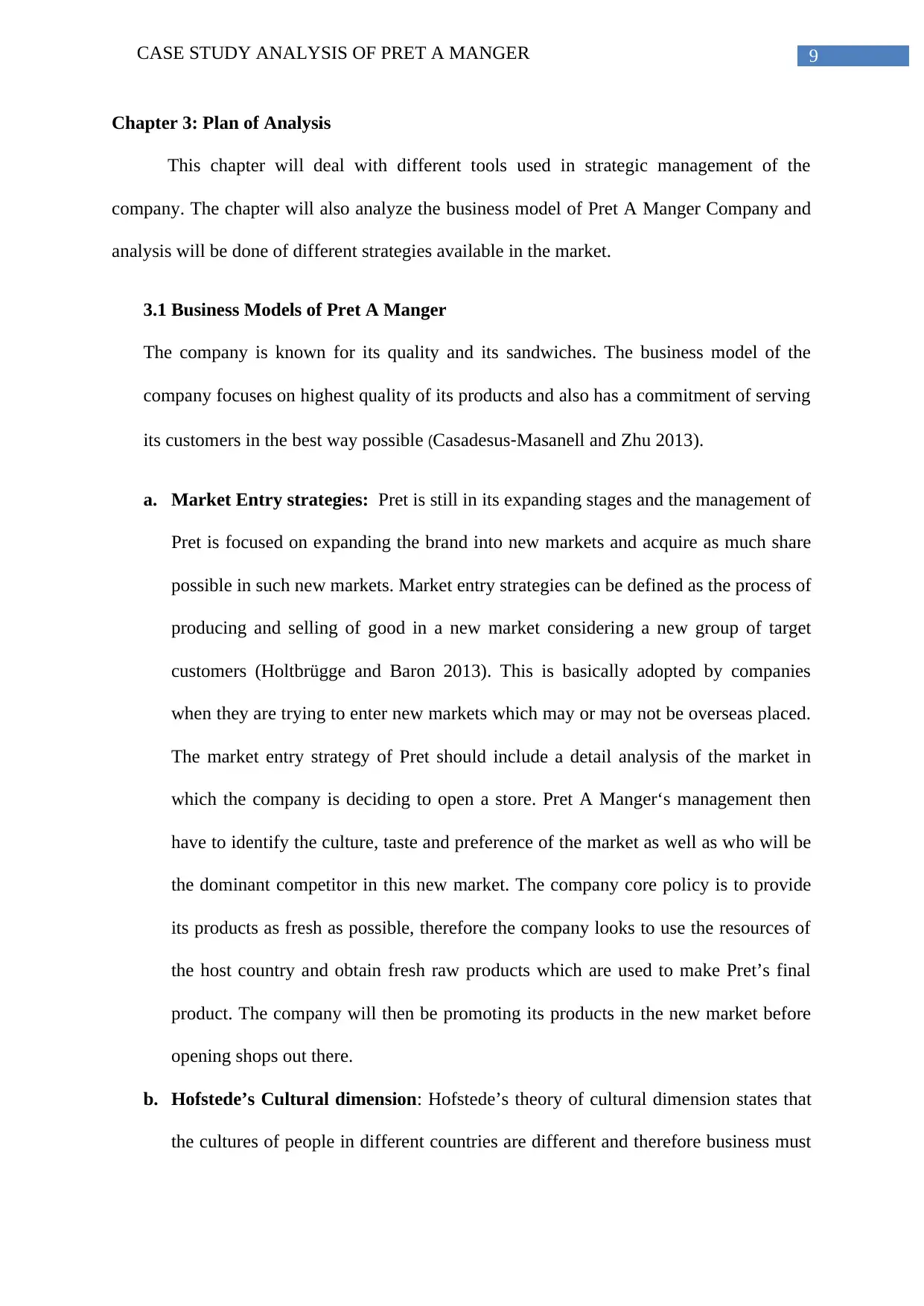
9CASE STUDY ANALYSIS OF PRET A MANGER
Chapter 3: Plan of Analysis
This chapter will deal with different tools used in strategic management of the
company. The chapter will also analyze the business model of Pret A Manger Company and
analysis will be done of different strategies available in the market.
3.1 Business Models of Pret A Manger
The company is known for its quality and its sandwiches. The business model of the
company focuses on highest quality of its products and also has a commitment of serving
its customers in the best way possible (Casadesus‐Masanell and Zhu 2013).
a. Market Entry strategies: Pret is still in its expanding stages and the management of
Pret is focused on expanding the brand into new markets and acquire as much share
possible in such new markets. Market entry strategies can be defined as the process of
producing and selling of good in a new market considering a new group of target
customers (Holtbrügge and Baron 2013). This is basically adopted by companies
when they are trying to enter new markets which may or may not be overseas placed.
The market entry strategy of Pret should include a detail analysis of the market in
which the company is deciding to open a store. Pret A Manger‘s management then
have to identify the culture, taste and preference of the market as well as who will be
the dominant competitor in this new market. The company core policy is to provide
its products as fresh as possible, therefore the company looks to use the resources of
the host country and obtain fresh raw products which are used to make Pret’s final
product. The company will then be promoting its products in the new market before
opening shops out there.
b. Hofstede’s Cultural dimension: Hofstede’s theory of cultural dimension states that
the cultures of people in different countries are different and therefore business must
Chapter 3: Plan of Analysis
This chapter will deal with different tools used in strategic management of the
company. The chapter will also analyze the business model of Pret A Manger Company and
analysis will be done of different strategies available in the market.
3.1 Business Models of Pret A Manger
The company is known for its quality and its sandwiches. The business model of the
company focuses on highest quality of its products and also has a commitment of serving
its customers in the best way possible (Casadesus‐Masanell and Zhu 2013).
a. Market Entry strategies: Pret is still in its expanding stages and the management of
Pret is focused on expanding the brand into new markets and acquire as much share
possible in such new markets. Market entry strategies can be defined as the process of
producing and selling of good in a new market considering a new group of target
customers (Holtbrügge and Baron 2013). This is basically adopted by companies
when they are trying to enter new markets which may or may not be overseas placed.
The market entry strategy of Pret should include a detail analysis of the market in
which the company is deciding to open a store. Pret A Manger‘s management then
have to identify the culture, taste and preference of the market as well as who will be
the dominant competitor in this new market. The company core policy is to provide
its products as fresh as possible, therefore the company looks to use the resources of
the host country and obtain fresh raw products which are used to make Pret’s final
product. The company will then be promoting its products in the new market before
opening shops out there.
b. Hofstede’s Cultural dimension: Hofstede’s theory of cultural dimension states that
the cultures of people in different countries are different and therefore business must
Paraphrase This Document
Need a fresh take? Get an instant paraphrase of this document with our AI Paraphraser
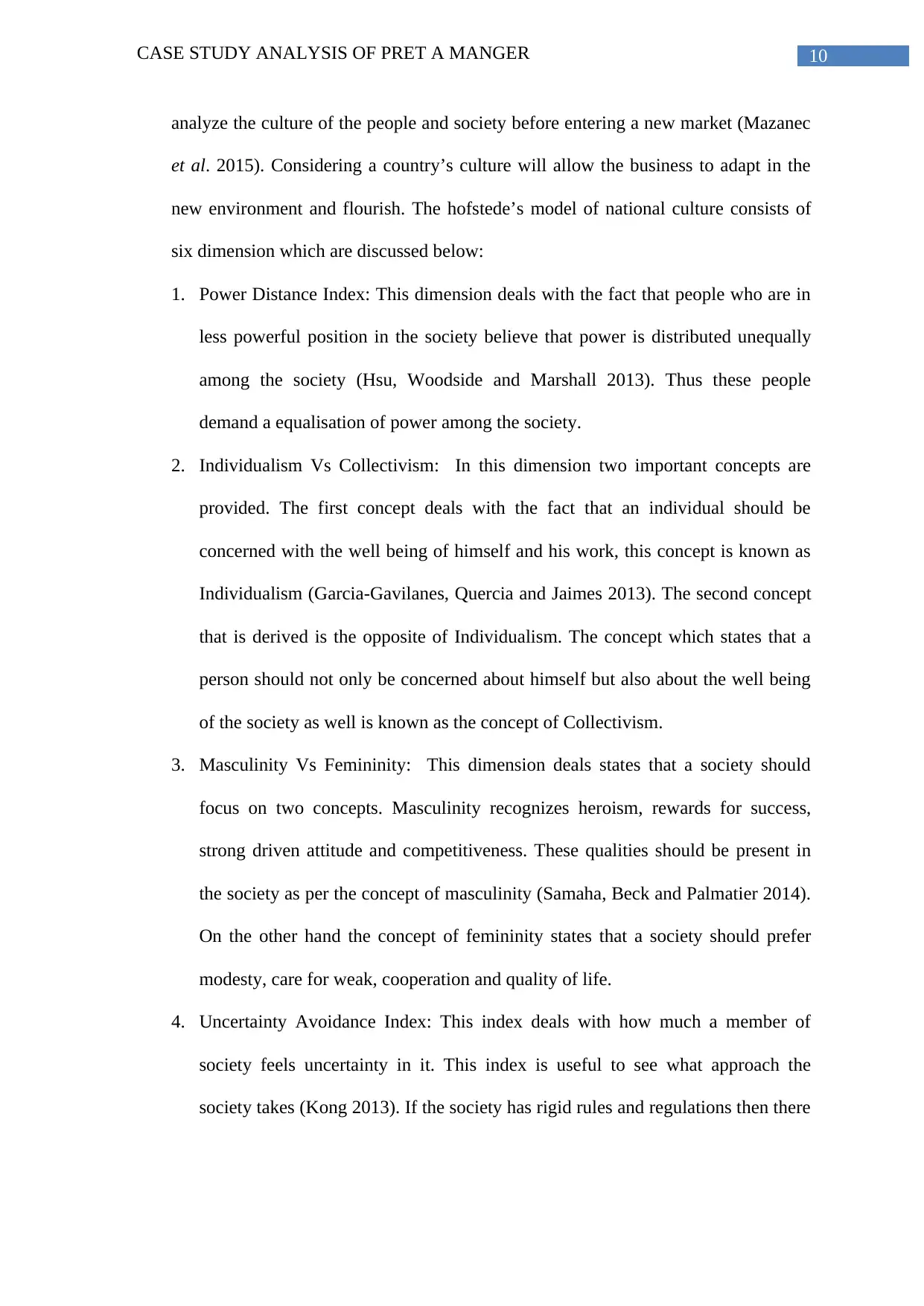
10CASE STUDY ANALYSIS OF PRET A MANGER
analyze the culture of the people and society before entering a new market (Mazanec
et al. 2015). Considering a country’s culture will allow the business to adapt in the
new environment and flourish. The hofstede’s model of national culture consists of
six dimension which are discussed below:
1. Power Distance Index: This dimension deals with the fact that people who are in
less powerful position in the society believe that power is distributed unequally
among the society (Hsu, Woodside and Marshall 2013). Thus these people
demand a equalisation of power among the society.
2. Individualism Vs Collectivism: In this dimension two important concepts are
provided. The first concept deals with the fact that an individual should be
concerned with the well being of himself and his work, this concept is known as
Individualism (Garcia-Gavilanes, Quercia and Jaimes 2013). The second concept
that is derived is the opposite of Individualism. The concept which states that a
person should not only be concerned about himself but also about the well being
of the society as well is known as the concept of Collectivism.
3. Masculinity Vs Femininity: This dimension deals states that a society should
focus on two concepts. Masculinity recognizes heroism, rewards for success,
strong driven attitude and competitiveness. These qualities should be present in
the society as per the concept of masculinity (Samaha, Beck and Palmatier 2014).
On the other hand the concept of femininity states that a society should prefer
modesty, care for weak, cooperation and quality of life.
4. Uncertainty Avoidance Index: This index deals with how much a member of
society feels uncertainty in it. This index is useful to see what approach the
society takes (Kong 2013). If the society has rigid rules and regulations then there
analyze the culture of the people and society before entering a new market (Mazanec
et al. 2015). Considering a country’s culture will allow the business to adapt in the
new environment and flourish. The hofstede’s model of national culture consists of
six dimension which are discussed below:
1. Power Distance Index: This dimension deals with the fact that people who are in
less powerful position in the society believe that power is distributed unequally
among the society (Hsu, Woodside and Marshall 2013). Thus these people
demand a equalisation of power among the society.
2. Individualism Vs Collectivism: In this dimension two important concepts are
provided. The first concept deals with the fact that an individual should be
concerned with the well being of himself and his work, this concept is known as
Individualism (Garcia-Gavilanes, Quercia and Jaimes 2013). The second concept
that is derived is the opposite of Individualism. The concept which states that a
person should not only be concerned about himself but also about the well being
of the society as well is known as the concept of Collectivism.
3. Masculinity Vs Femininity: This dimension deals states that a society should
focus on two concepts. Masculinity recognizes heroism, rewards for success,
strong driven attitude and competitiveness. These qualities should be present in
the society as per the concept of masculinity (Samaha, Beck and Palmatier 2014).
On the other hand the concept of femininity states that a society should prefer
modesty, care for weak, cooperation and quality of life.
4. Uncertainty Avoidance Index: This index deals with how much a member of
society feels uncertainty in it. This index is useful to see what approach the
society takes (Kong 2013). If the society has rigid rules and regulations then there
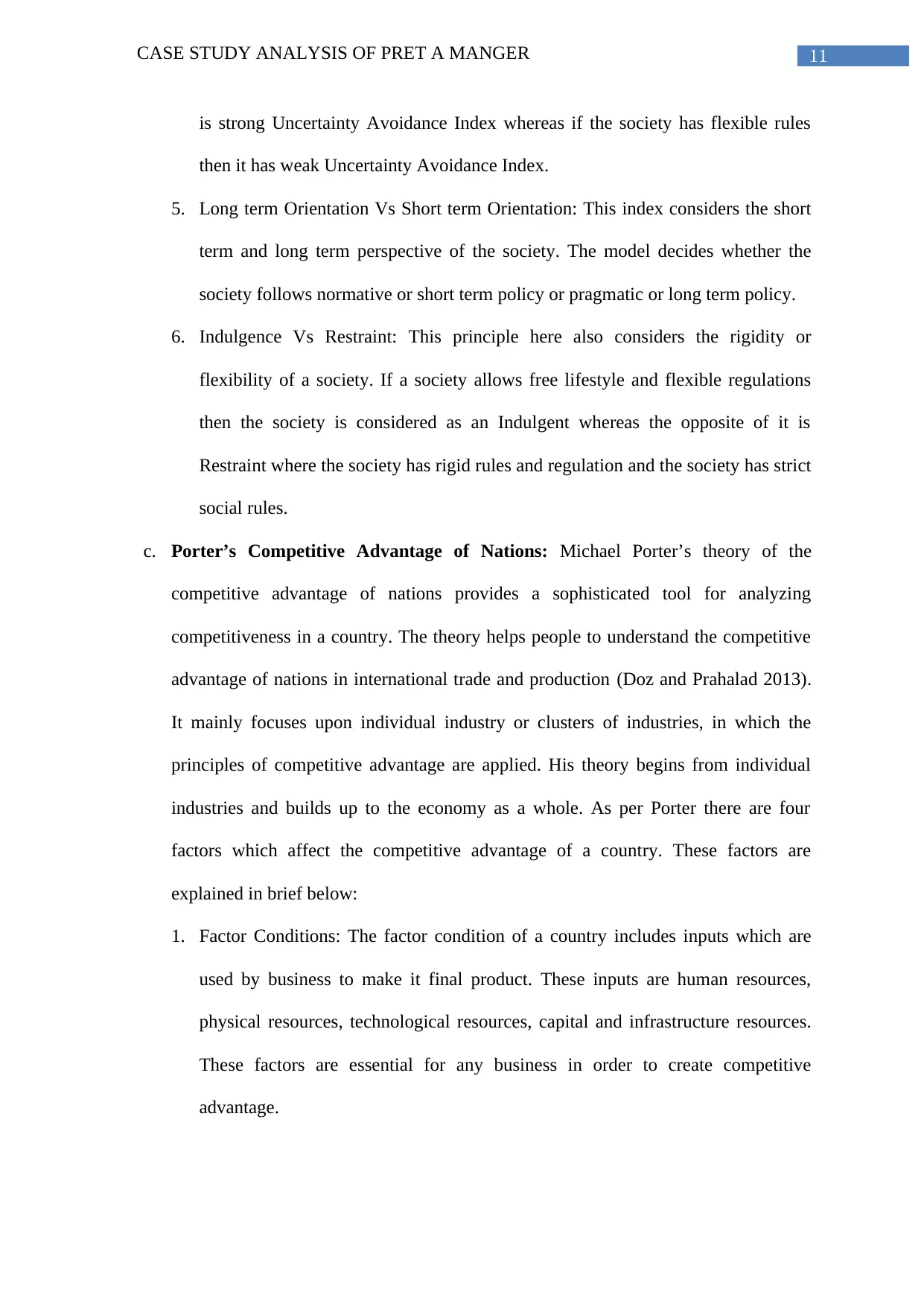
11CASE STUDY ANALYSIS OF PRET A MANGER
is strong Uncertainty Avoidance Index whereas if the society has flexible rules
then it has weak Uncertainty Avoidance Index.
5. Long term Orientation Vs Short term Orientation: This index considers the short
term and long term perspective of the society. The model decides whether the
society follows normative or short term policy or pragmatic or long term policy.
6. Indulgence Vs Restraint: This principle here also considers the rigidity or
flexibility of a society. If a society allows free lifestyle and flexible regulations
then the society is considered as an Indulgent whereas the opposite of it is
Restraint where the society has rigid rules and regulation and the society has strict
social rules.
c. Porter’s Competitive Advantage of Nations: Michael Porter’s theory of the
competitive advantage of nations provides a sophisticated tool for analyzing
competitiveness in a country. The theory helps people to understand the competitive
advantage of nations in international trade and production (Doz and Prahalad 2013).
It mainly focuses upon individual industry or clusters of industries, in which the
principles of competitive advantage are applied. His theory begins from individual
industries and builds up to the economy as a whole. As per Porter there are four
factors which affect the competitive advantage of a country. These factors are
explained in brief below:
1. Factor Conditions: The factor condition of a country includes inputs which are
used by business to make it final product. These inputs are human resources,
physical resources, technological resources, capital and infrastructure resources.
These factors are essential for any business in order to create competitive
advantage.
is strong Uncertainty Avoidance Index whereas if the society has flexible rules
then it has weak Uncertainty Avoidance Index.
5. Long term Orientation Vs Short term Orientation: This index considers the short
term and long term perspective of the society. The model decides whether the
society follows normative or short term policy or pragmatic or long term policy.
6. Indulgence Vs Restraint: This principle here also considers the rigidity or
flexibility of a society. If a society allows free lifestyle and flexible regulations
then the society is considered as an Indulgent whereas the opposite of it is
Restraint where the society has rigid rules and regulation and the society has strict
social rules.
c. Porter’s Competitive Advantage of Nations: Michael Porter’s theory of the
competitive advantage of nations provides a sophisticated tool for analyzing
competitiveness in a country. The theory helps people to understand the competitive
advantage of nations in international trade and production (Doz and Prahalad 2013).
It mainly focuses upon individual industry or clusters of industries, in which the
principles of competitive advantage are applied. His theory begins from individual
industries and builds up to the economy as a whole. As per Porter there are four
factors which affect the competitive advantage of a country. These factors are
explained in brief below:
1. Factor Conditions: The factor condition of a country includes inputs which are
used by business to make it final product. These inputs are human resources,
physical resources, technological resources, capital and infrastructure resources.
These factors are essential for any business in order to create competitive
advantage.
⊘ This is a preview!⊘
Do you want full access?
Subscribe today to unlock all pages.

Trusted by 1+ million students worldwide
1 out of 32
Related Documents
Your All-in-One AI-Powered Toolkit for Academic Success.
+13062052269
info@desklib.com
Available 24*7 on WhatsApp / Email
![[object Object]](/_next/static/media/star-bottom.7253800d.svg)
Unlock your academic potential
Copyright © 2020–2025 A2Z Services. All Rights Reserved. Developed and managed by ZUCOL.




